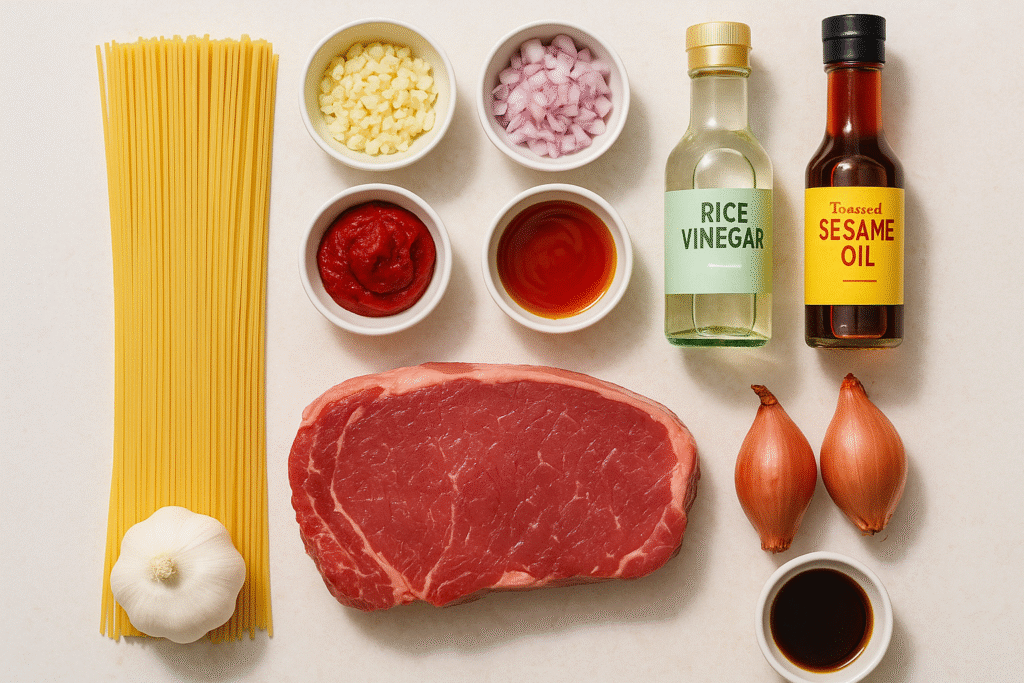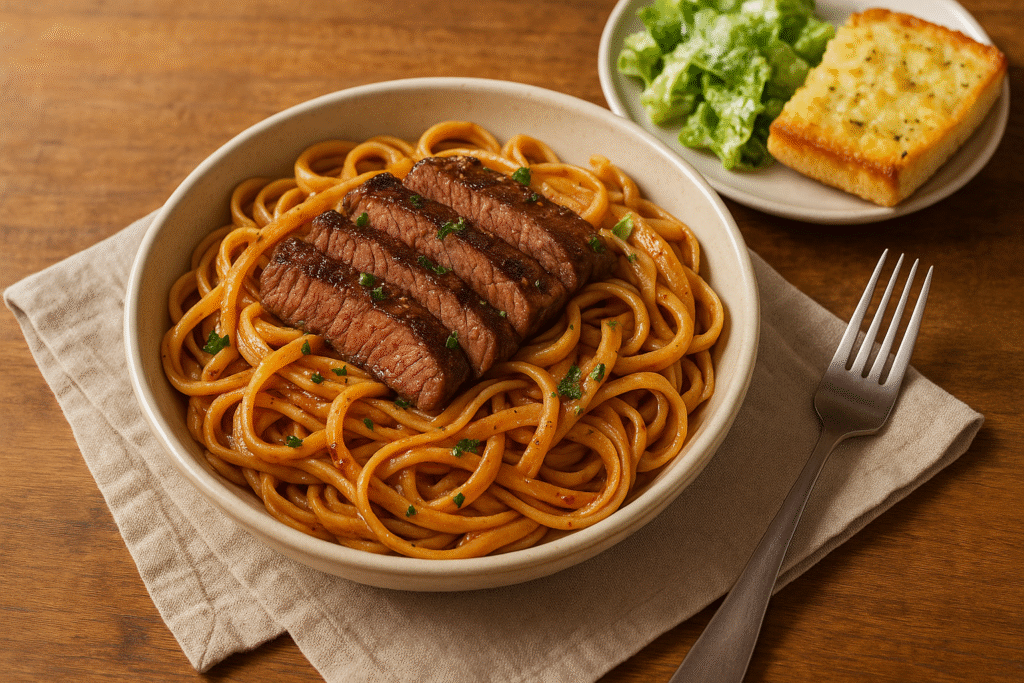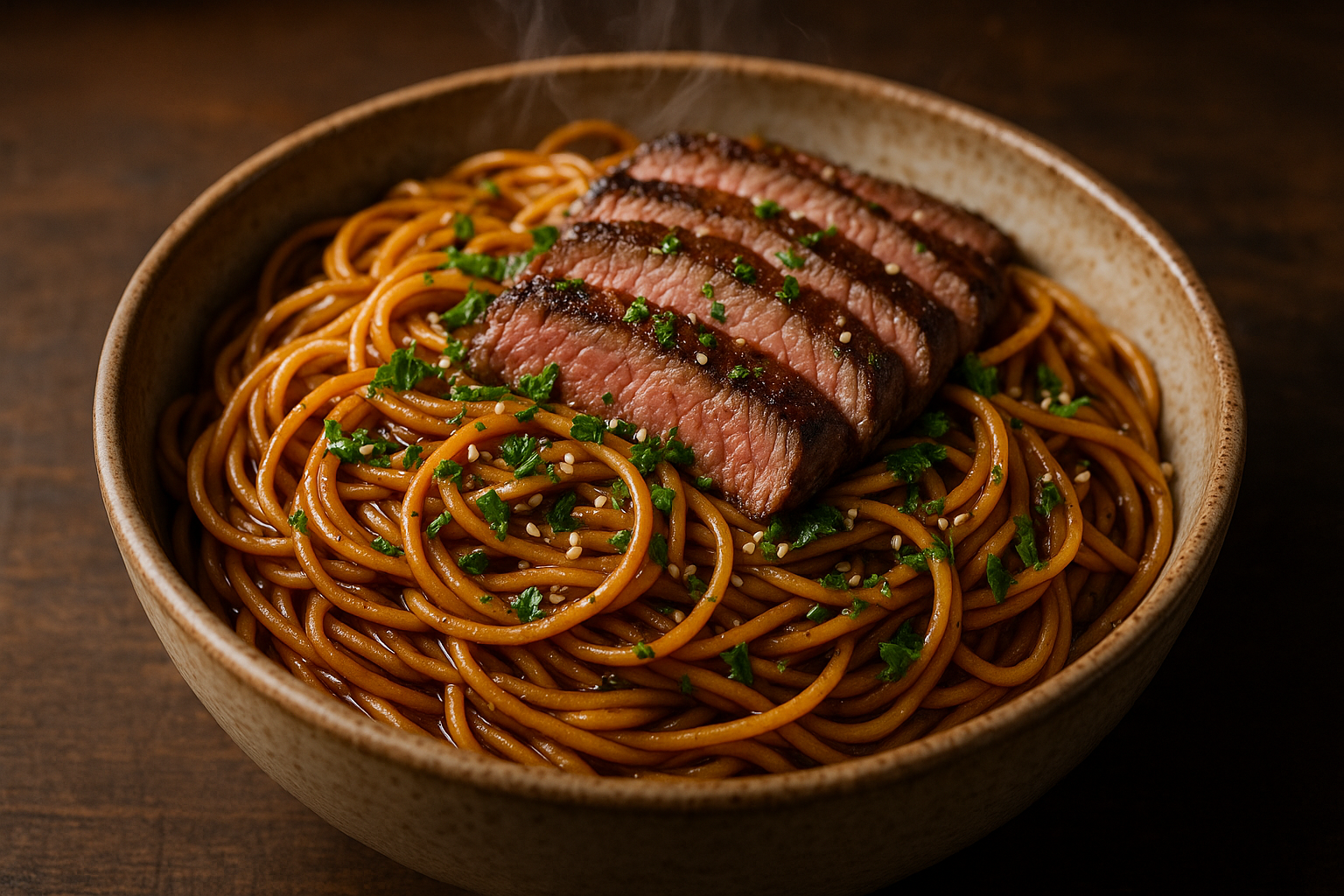Sweet and Spicy Garlic Steak Pasta: How to Wow 4 Guests
Table of Contents
Did you know the average American enjoys around 20 pounds of pasta each year? Collectively, that’s nearly 6 billion pounds annually, with a staggering 86% of us eating pasta at least once a week. Pasta is the undisputed champion of comfort food, the reliable staple we turn to for a satisfying meal. But with that much pasta on the menu, it’s easy to fall into a recipe rut. The same old spaghetti and meatballs, the familiar mac and cheese—they’re great, but sometimes you crave something more. You want a dish that’s both comforting and exciting, something that feels special without requiring a culinary degree and a full day in the kitchen.
This is where our Sweet and Spicy Garlic Steak Pasta comes in. It’s the perfect answer to the question, “What should I make for dinner tonight?” This dish delivers a restaurant-quality experience right in your own home, combining tender, perfectly seared steak with silky pasta, all tossed in an addictively complex sauce. It channels the “sweet heat” flavor profile that has become a defining culinary trend, blending familiar savory notes with a modern, spicy kick that keeps you coming back for more. Get ready to transform a simple weeknight into a memorable dining event.
Why You’ll Fall in Love with This Recipe
This isn’t just another pasta dish; it’s a complete culinary experience designed to impress. Here’s why this recipe will quickly become a fixture in your dinner rotation:
- A Symphony of Flavors: This dish is a masterclass in balance. You get the savory, umami-rich depth from soy sauce and seared steak, a luscious sweetness from honey, a complex, fermented heat from Gochujang, and a bright, aromatic punch from fresh garlic. It’s a bold, unforgettable combination.
- Restaurant-Quality, Beginner-Friendly: While it tastes like a gourmet meal from your favorite steakhouse, the process is surprisingly straightforward and comes together in under an hour. It’s the ultimate “impressive but easy” recipe, perfect for a special date night or a satisfying weeknight indulgence.
- Built on Pantry Staples: The heart of the incredible sauce is built from ingredients you likely already have on hand, like soy sauce, honey, garlic, and vinegar. With a few fresh additions, you can create something truly spectacular without a special trip to the store.
- Highly Adaptable for Every Eater: Whether you need a gluten-free option or want to dial the spice up or down, this recipe is incredibly flexible. We provide simple swaps to ensure everyone at your table can enjoy it.
- Perfect for Entertaining: This recipe is scaled to perfectly serve four guests, making it an ideal choice for a small dinner party or a family meal where you want to serve something a little extra special.
- Hearty, Satisfying, and Comforting: This is a protein-packed meal that delivers on every level. It’s deeply comforting, incredibly satisfying, and guaranteed to earn you rave reviews from your dinner guests.
- Tested, Perfected, and Full of Pro Tips: We’ve meticulously tested this recipe, combining chef-inspired techniques to ensure you get perfect results every single time. We don’t just tell you what to do; we explain why it works.
The Cast of Characters: Ingredients You’ll Need (Serves 4)
The magic of this dish lies in using quality ingredients and understanding the role each one plays. We’ve broken it down into three key components.
For the Perfect Pan-Seared Steak:
- Steak: 1.5 lbs Sirloin or Ribeye Steak. Sirloin is a fantastic, flavorful, and budget-friendly choice that becomes incredibly tender when cooked and sliced correctly. For a more decadent, melt-in-your-mouth experience, a well-marbled Ribeye is an unbeatable upgrade.
- High-Smoke-Point Oil: 1 tbsp Olive Oil or Avocado Oil, for searing.
- Seasoning: Coarse Salt and freshly cracked Black Pepper.
For the Sweet & Spicy Garlic Sauce:
- Aromatics: 4-6 cloves Garlic, minced, and 1 large Shallot, finely diced. Garlic provides that essential, pungent bite, while shallots offer a milder, sweeter aromatic base that adds incredible depth.
- The Spicy Secret Weapon: 2-3 tbsp Gochujang (Korean Chili Paste). This is the star ingredient that provides a complex, smoky, and slightly sweet fermented heat. If you can’t find it, Sriracha is a good substitute, though it will be spicier and less complex.
- The Sweet Counterpart: 2 tbsp Honey. This balances the spice and umami, creating that addictive “sweet heat” profile.
- The Umami Foundation: 4 tbsp low-sodium Soy Sauce and 1 tbsp Rice Vinegar. This duo creates the savory, salty, and tangy backbone of the sauce.
- The Nutty Finish: 1 tsp Toasted Sesame Oil. A little goes a long way to add a wonderful, nutty aroma.
- The Richness: 2 tbsp Unsalted Butter. Added at the end, butter enriches the sauce, gives it a beautiful gloss, and helps it emulsify into a creamy coating.

For the Pasta and Garnish:
- Pasta: 1 lb Spaghetti or Rigatoni. Long strands like spaghetti are perfect for catching the glossy glaze of the sauce. Alternatively, tube shapes like rigatoni or penne are excellent for trapping the sauce inside, ensuring a flavorful bite every time.
- Pasta Water: About 1/2 cup, reserved. This starchy “liquid gold” is the key to creating a silky sauce that clings perfectly to the pasta.
- Garnish: Freshly chopped Parsley or thinly sliced Green Onions, and 1 tsp Toasted Sesame Seeds. These add a final touch of freshness and texture.
Ingredient Substitutions and Variations
One of the best things about this recipe is its flexibility. Here’s a quick guide to help you adapt it to your pantry and preferences.
| Ingredient | Substitution(s) | Notes on Flavor & Texture |
| Sirloin/Ribeye Steak | Flank Steak, NY Strip, Top Sirloin | Flank is leaner and must be sliced thinly against the grain for tenderness. NY Strip and Top Sirloin are both excellent, well-marbled alternatives. |
| Gochujang | Sriracha, Sambal Oelek, or 1 tsp Red Pepper Flakes + 1 tbsp Miso Paste | Sriracha is hotter and lacks the fermented depth. Sambal provides pure chili heat. The miso-chili flake combo is a great DIY hack to mimic the umami and spice. |
| Spaghetti/Rigatoni | Gluten-Free Pasta (e.g., Jovial, Banza), Fettuccine, Penne | Use a high-quality gluten-free pasta and cook it just to al dente. Brands made from brown rice or chickpeas hold their texture well. |
| Soy Sauce | Tamari or Coconut Aminos | Tamari is the perfect gluten-free substitute. Coconut aminos are a great soy-free option, offering a slightly sweeter, less salty flavor. |
| Honey | Maple Syrup or Brown Sugar | Maple syrup will lend a slightly different, earthier sweetness. Brown sugar works well but ensure it’s fully dissolved in the sauce. |
| Butter | Vegan Butter or Extra Olive Oil | A quality vegan butter will still provide richness. Using only olive oil will result in a slightly less creamy but equally delicious sauce. |
Mastering the Method: Step-by-Step Instructions
Follow these steps closely, and you’ll be rewarded with a dish that tastes like it came from a professional kitchen. The key is in the technique!
Step 1: Prepare Your Components (Mise en Place)
A smooth cooking process starts with having everything ready to go. For a dish that comes together this quickly at the end, preparation is everything.
- Cook the Pasta: Bring a large pot of salted water to a rolling boil. Add your pasta and cook according to package directions until al dente (still has a slight bite). Before draining, reserve at least 1 cup of the starchy pasta water. Drain the pasta and set aside.
- Mix the Sauce: In a small bowl, whisk together the Gochujang, honey, soy sauce, rice vinegar, and sesame oil. Set it near the stove.
- Prep the Steak: Pat the steak completely dry with paper towels. A dry surface is essential for getting a deep, flavorful crust. Season both sides generously with coarse salt and black pepper. For the absolute best results, salt the steak at least 40 minutes before cooking and let it sit at room temperature. This process, known as dry-brining, allows the salt to penetrate the meat and reabsorb its own juices, leading to a more flavorful, tender steak and a much better sear.
Step 2: Achieve the Perfect Steak Sear
This is where you build the foundational flavor of the entire dish. Don’t rush this step!
- Heat the Pan: Place a large, heavy-bottomed skillet (cast iron or stainless steel are best) over high heat. Add 1 tablespoon of olive oil. Let the pan get screaming hot—the oil should be shimmering and just starting to smoke.
- Sear the Steak: Carefully place the seasoned steak in the hot pan. You should hear a loud, aggressive sizzle. Cook for 3-5 minutes per side for medium-rare, depending on the thickness of your steak.
- Pro Technique – Frequent Flipping: For a truly superior crust and more even cooking, try flipping the steak every 30-45 seconds. This might seem counterintuitive, but it prevents the meat underneath the surface from overcooking (the dreaded “gray band”) and actually develops a better, more even crust through the Maillard reaction.
- Check for Doneness: The most reliable way to nail your desired temperature is with an instant-read meat thermometer. For medium-rare, pull the steak from the pan when it reaches an internal temperature of
130−135∘F (54−57∘C). - Rest the Steak: Transfer the seared steak to a cutting board and let it rest for a full 10 minutes before slicing. This is non-negotiable! Resting allows the juices to redistribute throughout the meat, ensuring every bite is tender and juicy.
Step 3: Build a Flavor-Packed Pan Sauce
Now, you’ll turn that same skillet into a flavor factory.
- Sauté Aromatics: Reduce the heat under the skillet to medium. There should be a thin layer of steak drippings left in the pan. Add the diced shallot and cook for 2-3 minutes until softened. Add the minced garlic and cook for another 30-60 seconds until fragrant, being careful not to burn it.
- Deglaze the Pan: Pour the prepared sauce mixture into the skillet. As it bubbles, use a wooden spoon or spatula to scrape up all the browned bits (fond) from the bottom of the pan. This is where all the concentrated steak flavor lives, and incorporating it into your sauce is the secret to restaurant-quality depth. Let the sauce simmer for 1-2 minutes to thicken slightly.
Step 4: Bring It All Together
This is the final, exciting step where the magic happens.
- Finish the Sauce: Reduce the heat to low and add the 2 tablespoons of butter to the skillet, swirling the pan until it melts and emulsifies into the sauce, creating a rich, glossy finish.
- Add the Pasta: Add the drained pasta directly to the skillet with the sauce. Toss everything together vigorously. Add a few splashes of the reserved pasta water as you toss. The starch in the water will help the sauce bind to the pasta, creating a perfectly silky, non-greasy coating that clings to every noodle.
- Slice the Steak: While the pasta is mingling with the sauce, slice your rested steak thinly against the grain. To do this, look for the direction the muscle fibers are running and cut perpendicular to them. This shortens the fibers and makes the meat significantly more tender to eat.
- Combine and Serve: Add the sliced steak and any juices that have accumulated on the cutting board back into the skillet with the pasta. Give it one final toss to combine. Divide the pasta among four bowls, top with fresh parsley or green onions and a sprinkle of toasted sesame seeds. Serve immediately and get ready for the applause.
Plating and Pairing: Serving Suggestions
While this Sweet and Spicy Garlic Steak Pasta is a stunning meal all on its own, the right side dish can elevate it into a full-blown feast. The key is balance—pair the rich, savory pasta with something that offers a fresh, crisp contrast.

- For a Fresh, Crisp Contrast: The richness of the steak and sauce begs for a bright, acidic counterpoint. A Grilled Caesar Salad is an excellent choice; the smoky char on the lettuce beautifully complements the seared steak. For something even simpler, a vibrant
Caprese Salad with Avocado provides creamy freshness that cuts through the heat and savory notes of the pasta. - For an Elegant Vegetable Side: Simple roasted vegetables are a perfect partner. Try Roasted Asparagus drizzled with lemon juice or Roasted Broccoli Rabe with a pinch of chili flakes. The slight, earthy bitterness of these greens provides a sophisticated contrast to the dish’s sweet and spicy profile.
- For a Hearty, Comforting Meal: If you’re leaning into the full comfort-food experience, you can’t go wrong with classic Cheesy Garlic Bread. It’s perfect for soaking up every last drop of that incredible sauce. Simple
Sautéed Zucchini with Parmesan also works beautifully, adding another layer of savory flavor without being too heavy. - Wine Pairing: For red wine enthusiasts, a bold Cabernet Sauvignon is a classic pairing that stands up to the richness of the steak. If you prefer white, a crisp, acidic Sauvignon Blanc will cut through the sauce beautifully and refresh the palate between bites.
Plan Ahead & Save for Later: Storing Instructions
A great recipe is even better when it can fit into your busy life. Here’s how to prep this dish ahead of time and store leftovers for the best results.
Make-Ahead Preparation:
To get a head start on a busy night, you can absolutely do some prep in advance.
- The Sauce: Whisk all the sauce ingredients (Gochujang, honey, soy sauce, vinegar, sesame oil) together and store them in an airtight container or jar in the refrigerator for up to 3 days.
- The Pasta: You can cook the pasta ahead of time. After draining, toss it with a teaspoon of olive oil to prevent it from sticking together, let it cool, and store it in an airtight container in the fridge for up to 2 days.
Storing and Reheating Leftovers:
To preserve the amazing texture of this dish, a little care goes a long way. The biggest enemies of leftover steak pasta are tough, overcooked steak and mushy pasta.
- The Golden Rule: Store Separately! For the best possible next-day experience, store the sliced steak and the sauced pasta in separate airtight containers in the refrigerator. They will keep well for 3 to 4 days. Storing them together can cause the steak to become tough when reheated and the pasta to become overly soft.
- Reheating the Pasta: Gently reheat the sauced pasta in a skillet over low-medium heat. Add a splash of water, broth, or milk to loosen the sauce and bring it back to its original silky consistency. Stir gently until warmed through.
- Reheating the Steak: You have two great options for the steak. You can either add the cold, sliced steak directly to the hot pasta for the last 30 seconds of reheating (just enough to take the chill off without cooking it further), or you can enjoy it at room temperature or even cold. Microwaving the steak is not recommended, as it will almost certainly overcook and become tough.
Conclusion: Your New Favorite Dinner Awaits
This Sweet and Spicy Garlic Steak Pasta is more than just a recipe—it’s a formula for a perfect meal. It strikes that elusive balance between being weeknight-achievable and weekend-impressive. With its layers of savory, sweet, and spicy flavors, perfectly cooked steak, and silky noodles, it’s a dish that’s guaranteed to become a new favorite for you, your family, and your guests. It’s proof that you don’t need to go out to a restaurant to enjoy an extraordinary meal.
We can’t wait for you to try this Sweet and Spicy Garlic Steak Pasta! When you do, please come back and leave a comment and a star rating below—we love hearing about your experience and seeing your creations!

Sweet and Spicy Garlic Steak Pasta
Ingredients
Method
- Cook Pasta: Boil pasta in salted water until al dente. Reserve 1 cup of pasta water before draining.
- Prep: While pasta cooks, whisk together Gochujang, honey, soy sauce, rice vinegar, and sesame oil in a small bowl. Pat steak dry and season generously with salt and pepper.
- Sear Steak: Heat olive oil in a large cast-iron or stainless steel skillet over high heat until shimmering. Sear steak for 3-5 minutes per side for medium-rare (130−135∘F), or until desired doneness. Transfer to a cutting board and let it rest for 10 minutes.
- Build Sauce: Reduce skillet heat to medium. Sauté shallot until softened (2-3 mins), then add garlic until fragrant (30-60 secs). Pour in the sauce mixture, scraping the bottom of the pan to release browned bits (fond). Simmer for 1-2 minutes.
- Combine: Reduce heat to low and melt the butter into the sauce. Add the drained pasta and toss, adding splashes of reserved pasta water until the sauce is silky and clings to the noodles.
- Finish: Slice the rested steak thinly against the grain. Add the steak and any accumulated juices to the skillet with the pasta. Toss to combine.
- Serve: Divide among four bowls. Garnish with fresh parsley and toasted sesame seeds. Serve immediately.
Notes
- Dry Brine Tip: For an extra tender and flavorful steak, season it with salt and let it sit at room temperature for at least 40 minutes before cooking.
- Resting is Crucial: Do not skip resting the steak. It’s the most important step for ensuring a juicy result.
- Pasta Water is Key: The starchy water helps emulsify the sauce, creating the perfect silky texture.
- Storing: For best results, store leftover steak and sauced pasta in separate airtight containers in the refrigerator for up to 4 days.
Your Questions, Answered: FAQs
What is the best cut of steak for this pasta?
For a great balance of flavor and value, top sirloin is an excellent choice. If you’re looking to make the dish extra special, a well-marbled cut like ribeye or New York strip will be incredibly tender and flavorful.
I can’t find Gochujang. What can I use instead?
No problem! The best substitute for heat and a touch of sweetness is Sriracha. Start with a little less, as it can be spicier. For pure chili heat without the sweetness, you can use Sambal Oelek. For a non-spicy but umami-rich alternative, a tablespoon of miso paste mixed with a teaspoon of red pepper flakes is a great DIY option.
How spicy is this dish? Can I make it milder?
This dish has a pleasant, warming kick rather than being overwhelmingly spicy. The spice level is very easy to customize! For a milder version, simply reduce the amount of Gochujang or Sriracha to 1 tablespoon, or adjust to your personal taste.
Can I make this gluten-free?
Absolutely! To make this recipe gluten-free, use a high-quality gluten-free pasta (brown rice or chickpea-based fusilli and farfalle work well) and substitute the soy sauce with an equal amount of gluten-free tamari.
My sauce seems too thick or too thin. How do I fix it?
This is an easy fix and exactly why you reserved that pasta water! If your sauce is too thick, whisk in the starchy pasta water one tablespoon at a time until it reaches a smooth, glossy consistency. If the sauce seems too thin, simply let it simmer over low heat for another minute or two to allow it to reduce and thicken further.
Why is it so important to rest the steak after cooking?
Resting is a critical step for a juicy, tender steak. When you cook meat, the muscle fibers tense up and push the juices toward the center. Letting the steak rest for at least 10 minutes allows those fibers to relax and the juices to redistribute evenly throughout the meat. If you slice into it too early, all that delicious flavor will run out onto your cutting board instead of staying in the steak.
Can I use a different type of pasta?
Of course! While spaghetti and rigatoni are great choices, this sauce is delicious with many pasta shapes. Fettuccine, penne, fusilli, or even a sturdy pappardelle would all be fantastic options. The most important thing is to choose a shape that you enjoy and that has some texture to help catch all of that amazing sauce.
Did You Love Our Recipe?
There are no reviews yet. Be the first one to write one.
